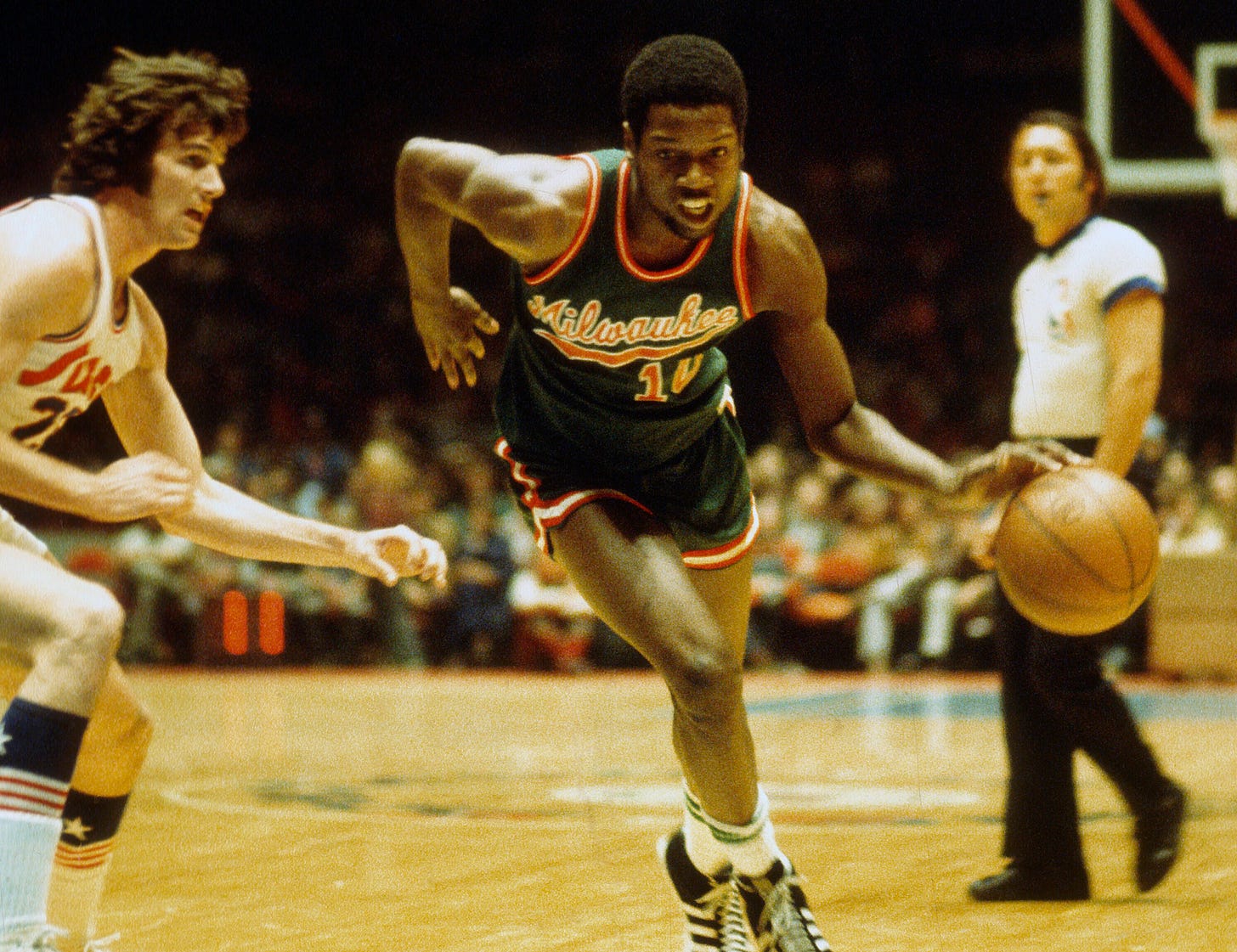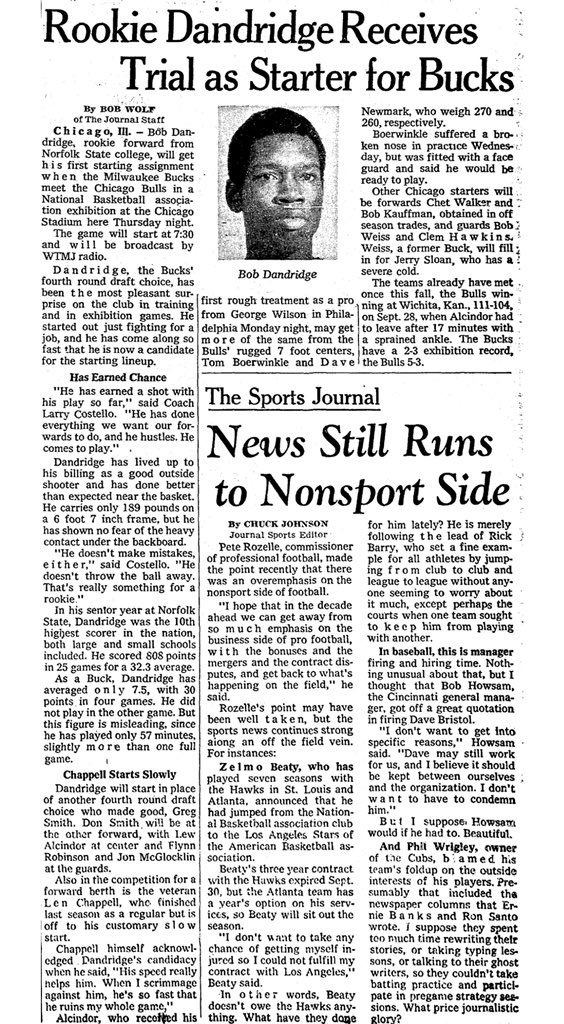When the Greyhound ran through Milwaukee
Reflecting on Bob Dandridge's legendary Milwaukee Bucks career as he enters the Hall of Fame
We couldn’t let Bob Dandridge’s long overdue induction into the Hall of Fame pass by without taking a moment to write about one of the greatest Bucks ever. Plus, we’ve been doing a lot of thinking about Dandridge and that era of the Bucks lately…
For more on the 1971 championship team and the beginnings of the Bucks, make sure you’re subscribed here as over the next few months we’ll start to share tidbits related to our upcoming documentary podcast series on that era of Milwaukee basketball. Yes, the big project we’ve teased is about the Bucks’ first championship (and a whole host of other weird and wonderful stuff that’s at least somewhat related). The plan is for the podcast to release in 2022, but we’ll pull back the curtain from time to time for those of you following along with us on Substack.
There was no historic coin flip to determine where Bob Dandridge was going on the night of the 1969 NBA Draft.
The Milwaukee Bucks’ fortunes had already drastically changed by winning the first overall pick that led them to holding the draft rights to the NBA’s eventual all-time scoring leader, Kareem Abdul-Jabbar.
Fresh off of their 27-win expansion season, there were infinite possibilities as to where the Bucks’ future was headed and they only grew greater as the draft wore on.
Back then, NBA Drafts were interminably long. That year, when there were 14 teams in the league, it took 20 rounds and 218 draft picks to make up that year’s class. While the likes of Abdul-Jabbar and ninth overall pick, Jo Jo White, went on to have Hall of Fame careers, the vast majority of draft selections that year weren’t guaranteed spots on opening night rosters going into the 1969-70 season.
It may seem almost impossible to imagine now, but that sentiment was once applicable to Dandridge, who will enter the Hall of Fame over 52 years on from being selected with the 45th overall pick by the Bucks.
Dandridge was fresh off of an incredibly prolific four-year stint at Norfolk State University in Virginia. He averaged double figures in points and rebounds in each of his sophomore, junior and senior seasons, the latter of which was capped off by averaging 32.3 points per game on 55.2 percent shooting from the field and 17 rebounds per game.
Yet, for all of the feats and extraordinary performances he put in for the Spartans, there were significant factors that Dandridge had to fight against in order to get drafted coming out of college.
For one, playing at a Division II school as Dandridge did meant there was no guarantee of him showing up on the radar of NBA teams. That wouldn’t be an issue today, but given the differences in scouting, technology and the infrastructure of the league as a whole, it certainly was at that point. There were also the more significant and insidious stereotypes Dandridge had to fight against coming out of a HBCU as Dandridge told Sports Illustrated’s Curry Kirkpatrick back in January of 1979:
"Back then, the players from the black schools all had the stigma of not being well-rounded," Dandridge says, "but in the summers I'd travel to some of the Northern cities, play against better competition and work on my defense. The only reason I made it at Milwaukee that first year was because I could overplay people."
As he said himself, it didn’t take long for Dandridge’s skill and talent to be noticed upon his arrival in Milwaukee, despite his own worries over whether he’d have a job after training camp. Dandridge reflected on his arrival and first camp experience with the Bucks while speaking to the Milwaukee Journal Sentinel back in February 2015:
"Going to Milwaukee was the right place at the right time for me," Dandridge said. "They were looking for a young guy to star at the small forward spot with Kareem.
"I remember I did well coming out of rookie camp and our trainer, Arnie Garber, nodded to me after we left Marquette," Dandridge said. "He said, 'If you play like you did the last three days, you're going to be here awhile.'"
The rest, as they say, is history. Not to say that there weren’t other twists and turns still to come.
Dandridge immediately fortified the Bucks as a starter. And the team quickly grew into a powerhouse from there, as evidenced by their 56-win season in 69-70.
Playoff heartbreak set in soon after as the Bucks ran into that year’s eventual NBA champions, the New York Knicks, during the Eastern Conference semi-finals. However, the Bucks responded to that loss by pulling off the biggest acquisition in franchise history, trading for Oscar Robertson just a day after the end to that season.
The acquisition of The Big O helped to spur Dandridge and his teammates on to the next level, but it could have been very different for the Virginia native.
Robertson’s relationship with the Cincinnati Royals, and particularly then Royals head coach Bob Cousy, had collapsed beyond repair. That’s what opened the door for Milwaukee to pick up Robertson and change the trajectory of their franchise. But a deal for Robertson was not straightforward for his suitors, and even less so for Cincinnati. Robertson had the equivalent of a no-trade clause in his contract, affording him the right to veto any potential deal. In fact, that’s an option he’d already used to prevent a trade to Baltimore going through even before the Bucks had entered the mix.
But when Milwaukee did express interest, Oscar had his heart set on the Bucks, and also on ensuring the team he wanted to join would still be strong enough to win a championship following the trade. Robertson’s account of those negotiations, as recalled in his autobiography (The Big O), suggests that Dandridge could easily have found himself traded to Cincinnati in that landmark deal. But as it turned out, Dandridge’s strong rookie season had not gone unnoticed by the legendary point guard who would soon become his teammate:
“The Bucks were going to offer their starting forward Bobby Dandridge for me and put a kid name Bob Greacen in Dandridge’s place. Dandridge had just finished his rookie season, and he had an awful lot of potential. I wasn’t about to go there if they messed up their starting unit. I told J.W [Brown, a University of Cincinnati booster and advisor to Robertson throughout his career] that if the Bucks traded Dandridge or Greg Smith, there would be no deal.”
In the end, Robertson was traded to Milwaukee, with Flynn “Electric Eye” Robinson and Charlie Paulk going the other way to Cincinnati. Greacen was highly regarded at the time, but ultimately played just nine total games in the Bucks’ championship season before moving to the ABA and playing for a single season before his career came to an end.
It’s certainly possible that Robertson overstated his role in ensuring Dandridge wasn’t involved in the trade, but he did hold that kind of leverage in the negotiations. And whether it was Robertson or the Bucks, the fact that there was sufficient foresight and recognition to know that post rookie Dandridge was already so much more than the 45th pick he’d been selected with a year prior was of monumental importance. On paper, Dandridge fit the bill of a player who could easily have been a throw in to close a deal for an all-time great point guard, but it was by remaining in Milwaukee and winning alongside Robertson and Abdul-Jabbar that his legacy ultimately became one of a champion and an all-time great in his own right.
It was in Milwaukee where Dandridge’s career blossomed into what can now be referred to as a Hall of Fame career. No player in Bucks history has played more minutes than Dandridge at 22,094 minutes, he’s third on the all-time appearances list behind Sidney Moncrief and Junior Bridgeman and he’s one of only seven players to score over 10,000 points while donning a Bucks uniform.
Furthermore, Dandridge is the second-leading scorer of that aforementioned 1969 NBA Draft class, standing only behind Abdul-Jabbar.
His story didn’t just stop in Milwaukee as he enjoyed another championship run when he helped the Washington Bullets to a title during the 1977-78 season. And it was his years flanking Abdul-Jabbar and Robertson that proved to be incredibly valuable to Dandridge in assuming a leading role on that Bullets team.
As was the case in his wait to have his jersey retired by the Bucks, Dandridge has had to wait a long time – too long – for his enshrinement in the Hall of Fame. But once again, over time, Dandridge’s talent and contributions have shone through to the point where he could no longer be ignored. Just like he overcame the odds to leave his mark with the Bucks, he’s now done the same to earn a spot in Springfield where he belongs.






